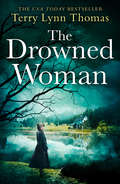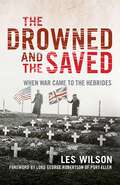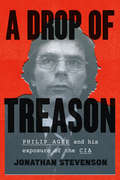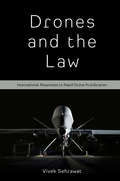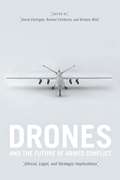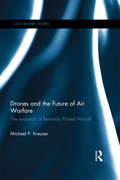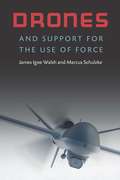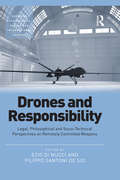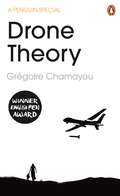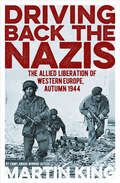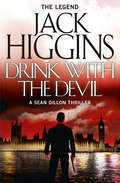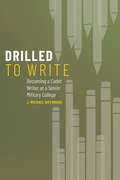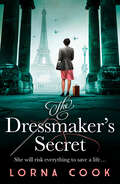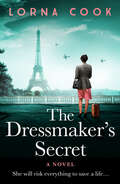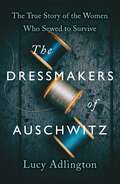- Table View
- List View
The Drowned Woman (The Sarah Bennett Mysteries #3)
by Terry Lynn ThomasFamily secrets won’t always stay buried…
The Drowned and the Saved: – Saltire Society History Book of The Year 2018
by Les Wilson'Next morning at about 6 o’clock my mother wakened us to say there had been a shipwreck and bodies were being washed ashore. My father had gone with others to look for survivors ... I don’t think any survivors came in at Port Ellen but bodies did.'The loss of two British ships crammed with American soldiers bound for the trenches of the First World War brought the devastation of war directly to the shores of the Scottish island of Islay.The sinking of the troopship Tuscania by a German U-Boat on 5 February 1918 was the first major loss of US troops in in the war. Eight months after the people of Islay had buried more than 200 Tuscania dead, the armed merchant cruiser Otranto collided with another troopship during a terrible storm. Despite a valiant rescue attempt by HMS Mounsay, the Otranto drifted towards Islay, hit a reef, throwing 600 men into the water. Just 19 survived; the rest were drowned or crushed by the wreckage.Based on the harrowing personal recollection of survivors and rescuers, newspaper reports and original research, Les Wilson tells the story of these terrible events, painting a vivid picture which also pays tribute to the astonishing bravery of the islanders, who risked their lives pulling men from the sea, caring for survivors and burying the dead.
A Drop of Treason: Philip Agee and His Exposure of the CIA
by Jonathan StevensonPhilip Agee’s story is the stuff of a John le Carré novel—perilous and thrilling adventures around the globe. He joined the CIA as a young idealist, becoming an operations officer in hopes of seeing the world and safeguarding his country. He was the consummate intelligence insider, thoroughly entrenched in the shadow world. But in 1975, he became the first such person to publicly betray the CIA—a pariah whose like was not seen again until Edward Snowden. For almost forty years in exile, he was a thorn in the side of his country. The first biography of this contentious, legendary man, Jonathan Stevenson’s A Drop of Treason is a thorough portrait of Agee and his place in the history of American foreign policy and the intelligence community during the Cold War and beyond. Unlike mere whistleblowers, Agee exposed American spies by publicly blowing their covers. And he didn’t stop there—his was a lifelong political struggle that firmly allied him with the social movements of the global left and against the American project itself from the early 1970s on. Stevenson examines Agee’s decision to turn, how he sustained it, and how his actions intersected with world events. Having made profound betrayals and questionable decisions, Agee lived a rollicking, existentially fraught life filled with risk. He traveled the world, enlisted Gabriel García Márquez in his cause, married a ballerina, and fought for what he believed was right. Raised a conservative Jesuit in Tampa, he died a socialist expat in Havana. In A Drop of Treason, Stevenson reveals what made Agee tick—and what made him run.
A Drop of Treason: Philip Agee and His Exposure of the CIA
by Jonathan StevensonPhilip Agee’s story is the stuff of a John le Carré novel—perilous and thrilling adventures around the globe. He joined the CIA as a young idealist, becoming an operations officer in hopes of seeing the world and safeguarding his country. He was the consummate intelligence insider, thoroughly entrenched in the shadow world. But in 1975, he became the first such person to publicly betray the CIA—a pariah whose like was not seen again until Edward Snowden. For almost forty years in exile, he was a thorn in the side of his country. The first biography of this contentious, legendary man, Jonathan Stevenson’s A Drop of Treason is a thorough portrait of Agee and his place in the history of American foreign policy and the intelligence community during the Cold War and beyond. Unlike mere whistleblowers, Agee exposed American spies by publicly blowing their covers. And he didn’t stop there—his was a lifelong political struggle that firmly allied him with the social movements of the global left and against the American project itself from the early 1970s on. Stevenson examines Agee’s decision to turn, how he sustained it, and how his actions intersected with world events. Having made profound betrayals and questionable decisions, Agee lived a rollicking, existentially fraught life filled with risk. He traveled the world, enlisted Gabriel García Márquez in his cause, married a ballerina, and fought for what he believed was right. Raised a conservative Jesuit in Tampa, he died a socialist expat in Havana. In A Drop of Treason, Stevenson reveals what made Agee tick—and what made him run.
Drones and the Law: International Responses to Rapid Drone Proliferation
by Dr Vivek SehrawatThe growing ubiquity of drones means that they are more readily available for both terrorists and civilians to use. At the same time, the military use of drones has globalised. Yet regulations for their international use, both military and domestic, are sparse and lacking in clarity, and most books on the legality of drones tend to be written by journalists or activists. Drones and the Law: International Responses to Rapid Drone Proliferation presents a fresh, scholarly perspective on the increasingly complex relations between drone usage and international and privacy law. Combining expert insights into strategy, international law, international humanitarian law, targeted killing, ethics, and privacy, Vivek Sehrawat offers an important historical and context for understanding how drone usage has become widespread; investigates how international law and international humanitarian law on the use of force interact with the rapid proliferation of military drones; and outlines how civilian use of drones poses specific challenges to national privacy laws in large countries such as the UK, the USA, and India. Throughout, Sehrawat discusses potential world policies for drone strikes and counter terrorism and debunks myths about current drone capabilities and the law regarding drone usage, making this book a useful and timely addition to the growing literature on drones and the law. For its rigorous legal research that offers a precise, accurate, and authoritative account of the legal challenges posed by rapid drone proliferation, Drones and the Law is a must-read for students and scholars of law and international relations.
Drones and the Law: International Responses to Rapid Drone Proliferation
by Dr Vivek SehrawatThe growing ubiquity of drones means that they are more readily available for both terrorists and civilians to use. At the same time, the military use of drones has globalised. Yet regulations for their international use, both military and domestic, are sparse and lacking in clarity, and most books on the legality of drones tend to be written by journalists or activists. Drones and the Law: International Responses to Rapid Drone Proliferation presents a fresh, scholarly perspective on the increasingly complex relations between drone usage and international and privacy law. Combining expert insights into strategy, international law, international humanitarian law, targeted killing, ethics, and privacy, Vivek Sehrawat offers an important historical and context for understanding how drone usage has become widespread; investigates how international law and international humanitarian law on the use of force interact with the rapid proliferation of military drones; and outlines how civilian use of drones poses specific challenges to national privacy laws in large countries such as the UK, the USA, and India. Throughout, Sehrawat discusses potential world policies for drone strikes and counter terrorism and debunks myths about current drone capabilities and the law regarding drone usage, making this book a useful and timely addition to the growing literature on drones and the law. For its rigorous legal research that offers a precise, accurate, and authoritative account of the legal challenges posed by rapid drone proliferation, Drones and the Law is a must-read for students and scholars of law and international relations.
Drones and the Future of Armed Conflict: Ethical, Legal, and Strategic Implications
by David Cortright Rachel Fairhurst Kristen WallDuring the past decade, armed drones have entered the American military arsenal as a core tactic for countering terrorism. When coupled with access to reliable information, they make it possible to deploy lethal force accurately across borders while keeping one’s own soldiers out of harm’s way. The potential to direct force with great precision also offers the possibility of reducing harm to civilians. At the same time, because drones eliminate some of the traditional constraints on the use of force—like the need to gain political support for full mobilization—they lower the threshold for launching military strikes. The development of drone use capacity across dozens of countries increases the need for global standards on the use of these weapons to assure that their deployment is strategically wise and ethically and legally sound. Presenting a robust conversation among leading scholars in the areas of international legal standards, counterterrorism strategy, humanitarian law, and the ethics of force, Drones and the Future of Armed Conflict takes account of current American drone campaigns and the developing legal, ethical, and strategic implications of this new way of warfare. Among the contributions to this volume are a thorough examination of the American government’s legal justifications for the targeting of enemies using drones, an analysis of American drone campaigns’ notable successes and failures, and a discussion of the linked issues of human rights, freedom of information, and government accountability.
Drones and the Future of Armed Conflict: Ethical, Legal, and Strategic Implications
by David Cortright Rachel Fairhurst Kristen WallDuring the past decade, armed drones have entered the American military arsenal as a core tactic for countering terrorism. When coupled with access to reliable information, they make it possible to deploy lethal force accurately across borders while keeping one’s own soldiers out of harm’s way. The potential to direct force with great precision also offers the possibility of reducing harm to civilians. At the same time, because drones eliminate some of the traditional constraints on the use of force—like the need to gain political support for full mobilization—they lower the threshold for launching military strikes. The development of drone use capacity across dozens of countries increases the need for global standards on the use of these weapons to assure that their deployment is strategically wise and ethically and legally sound. Presenting a robust conversation among leading scholars in the areas of international legal standards, counterterrorism strategy, humanitarian law, and the ethics of force, Drones and the Future of Armed Conflict takes account of current American drone campaigns and the developing legal, ethical, and strategic implications of this new way of warfare. Among the contributions to this volume are a thorough examination of the American government’s legal justifications for the targeting of enemies using drones, an analysis of American drone campaigns’ notable successes and failures, and a discussion of the linked issues of human rights, freedom of information, and government accountability.
Drones and the Future of Armed Conflict: Ethical, Legal, and Strategic Implications
by David Cortright Rachel Fairhurst Kristen WallDuring the past decade, armed drones have entered the American military arsenal as a core tactic for countering terrorism. When coupled with access to reliable information, they make it possible to deploy lethal force accurately across borders while keeping one’s own soldiers out of harm’s way. The potential to direct force with great precision also offers the possibility of reducing harm to civilians. At the same time, because drones eliminate some of the traditional constraints on the use of force—like the need to gain political support for full mobilization—they lower the threshold for launching military strikes. The development of drone use capacity across dozens of countries increases the need for global standards on the use of these weapons to assure that their deployment is strategically wise and ethically and legally sound. Presenting a robust conversation among leading scholars in the areas of international legal standards, counterterrorism strategy, humanitarian law, and the ethics of force, Drones and the Future of Armed Conflict takes account of current American drone campaigns and the developing legal, ethical, and strategic implications of this new way of warfare. Among the contributions to this volume are a thorough examination of the American government’s legal justifications for the targeting of enemies using drones, an analysis of American drone campaigns’ notable successes and failures, and a discussion of the linked issues of human rights, freedom of information, and government accountability.
Drones and the Future of Armed Conflict: Ethical, Legal, and Strategic Implications
by David Cortright, Rachel Fairhurst, and Kristen Wall Rachel Fairhurst Kristen WallDuring the past decade, armed drones have entered the American military arsenal as a core tactic for countering terrorism. When coupled with access to reliable information, they make it possible to deploy lethal force accurately across borders while keeping one’s own soldiers out of harm’s way. The potential to direct force with great precision also offers the possibility of reducing harm to civilians. At the same time, because drones eliminate some of the traditional constraints on the use of force—like the need to gain political support for full mobilization—they lower the threshold for launching military strikes. The development of drone use capacity across dozens of countries increases the need for global standards on the use of these weapons to assure that their deployment is strategically wise and ethically and legally sound. Presenting a robust conversation among leading scholars in the areas of international legal standards, counterterrorism strategy, humanitarian law, and the ethics of force, Drones and the Future of Armed Conflict takes account of current American drone campaigns and the developing legal, ethical, and strategic implications of this new way of warfare. Among the contributions to this volume are a thorough examination of the American government’s legal justifications for the targeting of enemies using drones, an analysis of American drone campaigns’ notable successes and failures, and a discussion of the linked issues of human rights, freedom of information, and government accountability.
Drones and the Future of Armed Conflict: Ethical, Legal, and Strategic Implications
by David Cortright, Rachel Fairhurst, and Kristen Wall Rachel Fairhurst Kristen WallDuring the past decade, armed drones have entered the American military arsenal as a core tactic for countering terrorism. When coupled with access to reliable information, they make it possible to deploy lethal force accurately across borders while keeping one’s own soldiers out of harm’s way. The potential to direct force with great precision also offers the possibility of reducing harm to civilians. At the same time, because drones eliminate some of the traditional constraints on the use of force—like the need to gain political support for full mobilization—they lower the threshold for launching military strikes. The development of drone use capacity across dozens of countries increases the need for global standards on the use of these weapons to assure that their deployment is strategically wise and ethically and legally sound. Presenting a robust conversation among leading scholars in the areas of international legal standards, counterterrorism strategy, humanitarian law, and the ethics of force, Drones and the Future of Armed Conflict takes account of current American drone campaigns and the developing legal, ethical, and strategic implications of this new way of warfare. Among the contributions to this volume are a thorough examination of the American government’s legal justifications for the targeting of enemies using drones, an analysis of American drone campaigns’ notable successes and failures, and a discussion of the linked issues of human rights, freedom of information, and government accountability.
Drones and the Future of Armed Conflict: Ethical, Legal, and Strategic Implications
by David Cortright, Rachel Fairhurst, and Kristen Wall Rachel Fairhurst Kristen WallDuring the past decade, armed drones have entered the American military arsenal as a core tactic for countering terrorism. When coupled with access to reliable information, they make it possible to deploy lethal force accurately across borders while keeping one’s own soldiers out of harm’s way. The potential to direct force with great precision also offers the possibility of reducing harm to civilians. At the same time, because drones eliminate some of the traditional constraints on the use of force—like the need to gain political support for full mobilization—they lower the threshold for launching military strikes. The development of drone use capacity across dozens of countries increases the need for global standards on the use of these weapons to assure that their deployment is strategically wise and ethically and legally sound. Presenting a robust conversation among leading scholars in the areas of international legal standards, counterterrorism strategy, humanitarian law, and the ethics of force, Drones and the Future of Armed Conflict takes account of current American drone campaigns and the developing legal, ethical, and strategic implications of this new way of warfare. Among the contributions to this volume are a thorough examination of the American government’s legal justifications for the targeting of enemies using drones, an analysis of American drone campaigns’ notable successes and failures, and a discussion of the linked issues of human rights, freedom of information, and government accountability.
Drones and the Future of Air Warfare: The Evolution of Remotely Piloted Aircraft (Cass Military Studies)
by Michael P. KreuzerThis book examines the evolution of airpower and specifically the growth and proliferation of Remotely Piloted Aircraft (RPAs). While most existing literature examines either the law or ethics of RPAs, and some newer scholarship looks to the battlefield effectiveness (the gains from strikes versus the potential for ‘blowback, etc.), this work investigates it from a broader military perspective. It examines the strategy for employment of RPAs across the spectrum of warfare, the potential deterrent value of RPAs in some circumstances, and the resulting ability of RPAs to fundamentally shift the character of when and how wars are fought. The central aim of this book is to evaluate the role of ‘drones’ in warfare to date, and make basic projections on how states will adopt RPAs and UCAVs in the future. At the core is the goal of answering a broad, underlying research question: How will the RPA innovation impact military strategy and international security? This book will be of much interest to students of airpower, drone warfare, military and strategic studies, security studies and IR.
Drones and the Future of Air Warfare: The Evolution of Remotely Piloted Aircraft (Cass Military Studies)
by Michael P. KreuzerThis book examines the evolution of airpower and specifically the growth and proliferation of Remotely Piloted Aircraft (RPAs). While most existing literature examines either the law or ethics of RPAs, and some newer scholarship looks to the battlefield effectiveness (the gains from strikes versus the potential for ‘blowback, etc.), this work investigates it from a broader military perspective. It examines the strategy for employment of RPAs across the spectrum of warfare, the potential deterrent value of RPAs in some circumstances, and the resulting ability of RPAs to fundamentally shift the character of when and how wars are fought. The central aim of this book is to evaluate the role of ‘drones’ in warfare to date, and make basic projections on how states will adopt RPAs and UCAVs in the future. At the core is the goal of answering a broad, underlying research question: How will the RPA innovation impact military strategy and international security? This book will be of much interest to students of airpower, drone warfare, military and strategic studies, security studies and IR.
Drones and Support for the Use of Force
by James Igoe Walsh Marcus SchulzkeCombat drones are transforming attitudes about the use of military force. Military casualties and the costs of conflict sap public support for war and for political and military leaders. Combat drones offer an unprecedented ability to reduce these costs by increasing accuracy, reducing the risks to civilians, and protecting military personnel from harm. These advantages should make drone strikes more popular than operations involving ground troops. Yet many critics believe drone warfare will make political leaders too willing to authorize wars, weakening constraints on the use of force. Because combat drones are relatively new, these arguments have been based on anecdotes, a handful of public opinion polls, or theoretical speculation. Drones and Support for the Use of Force uses experimental research to analyze the effects of combat drones on Americans’ support for the use of force. The authors’ findings—that drones have had important but nuanced effects on support for the use of force—have implications for democratic control of military action and civil-military relations and provide insight into how the proliferation of military technologies influences foreign policy.
Drones and Responsibility: Legal, Philosophical and Socio-Technical Perspectives on Remotely Controlled Weapons (Emerging Technologies, Ethics and International Affairs)
by Ezio Di Nucci Filippo Santoni SioHow does the use of military drones affect the legal, political, and moral responsibility of different actors involved in their deployment and design? This volume offers a fresh contribution to the ethics of drone warfare by providing, for the first time, a systematic interdisciplinary discussion of different responsibility issues raised by military drones. The book discusses four main sets of questions: First, from a legal point of view, we analyse the ways in which the use of drones makes the attribution of criminal responsibility to individuals for war crimes more complicated and what adjustments may be required in international criminal law and in military practices to avoid ’responsibility gaps’ in warfare. From a moral and political perspective, the volume looks at the conditions under which the use of military drones by states is impermissible, permissible, or even obligatory and what the responsibilities of a state in the use of drones towards both its citizens and potential targets are. From a socio-technical perspective, what kind of new human machine interaction might (and should) drones bring and which new kinds of shared agency and responsibility? Finally, we ask how the use of drones changes our conception of agency and responsibility. The book will be of interest to scholars and students in (military) ethics and to those in law, politics and the military involved in the design, deployment and evaluation of military drones.
Drones and Responsibility: Legal, Philosophical and Socio-Technical Perspectives on Remotely Controlled Weapons (Emerging Technologies, Ethics and International Affairs)
by Ezio Di Nucci Filippo Santoni SioHow does the use of military drones affect the legal, political, and moral responsibility of different actors involved in their deployment and design? This volume offers a fresh contribution to the ethics of drone warfare by providing, for the first time, a systematic interdisciplinary discussion of different responsibility issues raised by military drones. The book discusses four main sets of questions: First, from a legal point of view, we analyse the ways in which the use of drones makes the attribution of criminal responsibility to individuals for war crimes more complicated and what adjustments may be required in international criminal law and in military practices to avoid ’responsibility gaps’ in warfare. From a moral and political perspective, the volume looks at the conditions under which the use of military drones by states is impermissible, permissible, or even obligatory and what the responsibilities of a state in the use of drones towards both its citizens and potential targets are. From a socio-technical perspective, what kind of new human machine interaction might (and should) drones bring and which new kinds of shared agency and responsibility? Finally, we ask how the use of drones changes our conception of agency and responsibility. The book will be of interest to scholars and students in (military) ethics and to those in law, politics and the military involved in the design, deployment and evaluation of military drones.
Drone Theory
by Grégoire ChamayouDrone Theory is Gregoire Chamayou's poignant and sharply argued polemic against US drone warfare.In 2011 alone, the US deployed one drone strike every four days in Pakistan. Drone Theory is a rigorous polemic against the increasing use of robot warfare around the world. Drawing on philosophical debate, moral lessons from Greek mythology and transcripts of conversations between drone operators, Drone Theory re-evaluates the socio-political impact of drone warfare on the world - and its people. Chamayou takes us through Nevada, Pakistan and arresting philosophical terrain to reveal how drones are changing the landscape of war theory and to highlight the profound moral implications of our own silence in the face of drone warfare.Born in 1976, Grégoire Chamayou is a philosopher at the Centre National de la Recherche Scientifique in Paris and the author of Les corps vils and Manhunts: A Philosophical History. Chamayou also lectures at Université de Paris Ouest, and has written for Le Monde Diplomatique among other publications. Janet Lloyd has translated over seventy books from French to English and has twice been awarded the Scott Moncrieff prize.
Driving Back the Nazis: The Allied Liberation of Western Europe, Autumn 1944
by Martin KingA gripping account of the Allied liberation of Western Europe, masterfully told by Emmy-award winning writer and historian Martin King. Through the autumn of 1944, Allied troops made their way across Nazi-occupied Europe, liberating towns and villages as they went. Driving Back the Nazis explores this process of liberation, from the arrival of Allied forces in Paris through the emancipation of Belgium to the closing down of Nazi prison camps. But there was a darker side to liberation too - collaborators were harshly punished, and in some cases the liberating forces brought their own troubles with them. Martin King tells the story of liberation from all sides - we hear the voices of Allied high command, ordinary American and British soldiers, local civilians, and even the defeated German forces.
Drink with the Devil (Sean Dillon Series #5)
by Jack HigginsTen years ago, a fortune in gold bullion was stolen, only to disappear beneath the Irish Sea. Now it’s been found, and Sean Dillon must face ghosts from his past in the race to get to it first.
Drilled to Write: Becoming a Cadet Writer at a Senior Military College
by J. Michael RifenburgDrilled to Write offers a rich account of US Army cadets navigating the unique demands of Army writing at a senior military college. In this longitudinal case study, J. Michael Rifenburg follows one cadet, Logan Blackwell, for four years and traces how he conceptualizes Army writing and Army genres through immersion in military science classes, tactical exercises in the Appalachian Mountains, and specialized programs like Airborne School. Drawing from research on rhetorical genre studies, writing transfer, and materiality, Drilled to Write speaks to scholars in writing studies committed to capturing how students understand their own writing development. Collectively, these chapters articulate four ways Blackwell leveraged resources through ROTC to become a cadet writer at this military college. Each chapter is dedicated to one year of his undergraduate experience with focus on curricular writing for his business management major and military science classes as well as his extracurricular writing, like his Ballroom Dance Club bylaws and a three-thousand-word short story. In Drilled to Write, Rifenburg invites readers to see how cadets are positioned between civilian and military life—a curiously liminal space where they develop as writers. Using Army ROTC as an entry into genre theory and larger conversations about the role higher education plays in developing Army officers, he shows how writing students develop genre awareness and flexibility while forging a personal identity.
The Dressmaker’s Secret
by Lorna Cook‘Extraordinary… Brought history alive on the page… Tense and emotional… Sensitive yet brutal…With the most unexpected end that left me breathless. Wow, just wow… Incredible’ NetGalley Review, ⭐⭐⭐⭐⭐ 1941, Nazi-occupied Paris: In the glamourous Ritz hotel there is a woman with a dangerous secret…
The Dressmaker’s Secret
by Lorna Cook‘Extraordinary… Brought history alive on the page… Tense and emotional… Sensitive yet brutal…With the most unexpected end that left me breathless. Wow, just wow… Incredible’ NetGalley Review, ⭐⭐⭐⭐⭐ 1941, Nazi-occupied Paris: In the glamourous Ritz hotel there is a woman with a dangerous secret…
The Dressmakers of Auschwitz: The True Story of the Women Who Sewed to Survive
by Lucy Adlington'Lucy Adlington tells of the horrors of the Nazi occupation and the concentration camps from a fascinating and original angle. She introduces us to a little known aspect of the period, highlighting the role of clothes in the grimmest of societies imaginable and giving an insight into the women who stayed alive by stitching' - Alexandra Shulman, author of Clothes...and other things that matter'An utterly absorbing, important and unique historical read' - Judy Batalion, NY Times bestselling author of The Light of Our Days: The Untold Story of Women Resistance Fighters in Hitler's GhettosThe powerful chronicle of the women who used their sewing skills to survive the Holocaust, stitching beautiful clothes at an extraordinary fashion workshop created within one of the most notorious WWII death camps. At the height of the Holocaust twenty-five young inmates of the infamous Auschwitz-Birkenau concentration camp - mainly Jewish women and girls - were selected to design, cut, and sew beautiful fashions for elite Nazi women in a dedicated salon. It was work that they hoped would spare them from the gas chambers. This fashion workshop - called the Upper Tailoring Studio - was established by Hedwig Höss, the camp commandant's wife, and patronized by the wives of SS guards and officers. Here, the dressmakers produced high-quality garments for SS social functions in Auschwitz, and for ladies from Nazi Berlin's upper crust. Drawing on diverse sources - including interviews with the last surviving seamstress - The Dressmakers of Auschwitz follows the fates of these brave women. Their bonds of family and friendship not only helped them endure persecution, but also to play their part in camp resistance. Weaving the dressmakers' remarkable experiences within the context of Nazi policies for plunder and exploitation, historian Lucy Adlington exposes the greed, cruelty, and hypocrisy of the Third Reich and offers a fresh look at a little-known chapter of World War II and the Holocaust.
The Dressmaker of Paris: 'A story of loss and escape, redemption and forgiveness. Fans of Lucinda Riley will adore it' (Sunday Express)
by Georgia Kaufmann'Involving, immersive and unputdownable' - bestselling author Jill MansellI need to tell you a story, ma chère. My story.Rosa Kusstatscher has built a global fashion empire upon her ability to find the perfect outfit for any occasion. But tonight, as she prepares for the most important meeting of her life, her usual certainty eludes her.What brought her to this moment? As she struggles to select her dress and choose the right shade of lipstick, Rosa begins to tell her incredible story. The story of a poor country girl from a village high in the mountains of Italy. Of Nazi occupation and fleeing in the night. Of hope and heartbreak in Switzerland; glamour and love in Paris. Of ambition and devastation in Rio de Janeiro; success and self-discovery in New York.A life spent running, she sees now. But she will run no longer.Breathtaking and utterly enthralling, The Dressmaker of Paris is perfect for fans of Lucinda Riley, Kate Morton and Dinah Jefferies.'The Dressmaker of Paris is a delicious book: elegantly structured, beautifully written and with a fascinating protagonist. Georgia Kaufmann has created a beautiful and compelling novel that had me hooked until the very last page. And that ending: wow!' - Gill Thompson, bestselling author of The Oceans Between Us'Sensuous, sweeping and utterly engrossing, The Dressmaker of Paris is as dazzling and finely crafted as a Dior gown' - Rachel Rhys, bestselling author of Dangerous Crossing'The story of a remarkable woman . . . A book you will lose yourself in' - Gill Paul, bestselling author of THE LOST DAUGHTER
